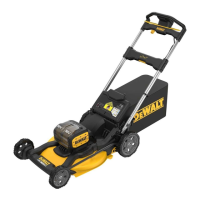60
ENGLISH
13. In this order, install the blade assembly
47
and keyed
spacer
45
onto the blade shaft
49
as shown in Fig. CC.
NOTE: Align the keys
46
on the keyed spacer
45
with the
key slots
60
on the bladeshaft
49
as shown in Fig.CC.
14. Install the blade assembly bolt
43
and hand tighten.
15. Position the 38 mm x 89 mm timber
42
between the blade
assembly
47
and outer lip of deck as shown in Fig. DD to
keep the blades from turning.
16. Fully tighten the blade assembly bolt
43
using a
14 mm (9/16")wrench
44
(not included). Torque the blade
assembly bolt
43
to 50-68 Nm (37-50 ft-lbs).
17. Return the mower to its normal uprightposition.
Blade Balancing (Fig. EE, FF)
Check balance of each blade
52
or
53
by placing the keyed
mounting hole
55
over a nail or round screwdriver
59
,
clamped horizontally in a vise
34
. If either end of a blade
rotates downward, file along the sharp edge of that dropping
end. Blade is properly balanced when neither enddrops.
Cleaning (Fig. A)
WARNING: Blow dirt and dust out of all air vents with
clean, dry air at least once a week. To minimize the risk
of eye injury, always wear approved eye protection and
approved dust mask when performing this procedure.
WARNING: Never use solvents or other harsh chemicals
for cleaning the non-metallic parts of the tool. These
chemicals may weaken the plastic materials used in
these parts. Use a cloth dampened only with water and
mild soap. Never let any liquid get inside the tool; never
immerse any part of the tool into aliquid.
• Release bail handle
8
to turn mower off, let the blades
come to a stop.
• Remove the battery pack and safety key.
• Clean out any clippings which may have accumulated on
the underside of the deck. Do not spray with water or any
other liquids.
• After several uses, check all exposed fasteners fortightness.
Corrosion (Fig. A)
Fertilizers and other garden chemicals contain agents which
greatly accelerate the corrosion of metals. If you mow in areas
where fertilizers or chemicals have been used, the mower
should be cleaned immediately afterward as follows:
Release bail handle
8
to turn mower off and remove battery
and safety key. Wipe all exposed parts with a dampcloth.
CAUTION: Do not pour or spray water on the mower
in an attempt to clean it. Do not store the tool on or
adjacent to fertilizers or chemicals. Such storage can cause
rapidcorrosion.
Blade Sharpening (Fig. EE)
KEEP BLADE SHARP FOR BEST MOWER PERFORMANCE. A DULL
BLADE DOES NOT CUT GRASSCLEANLY.
WARNING: Use gloves and proper eye protection while
removing, sharpening, and installing blades. Ensure that
safety key and battery pack areremoved.
Sharpening the blades twice during a mowing season is usually
sufficient under normal circumstances. Sand causes the blade
to dull quickly. If your lawn has sandy soil, more frequent
sharpening may berequired. REPLACE BENT OR DAMAGED
BLADESIMMEDIATELY.
When Sharpening a Blade:
• Make sure blade remainsbalanced.
• Sharpen blades at the original cuttingangle.
• Sharpen cutting edges on both ends of blade, removing
equal amounts of material from bothends.
To Sharpen Blade in a Vise (Fig. EE)
1. Be sure the bail handle is released, the blades have stopped
and safety key and battery pack are removed before
removing theblades.
2. Remove blades from mower. See instructions for Removing
and InstallingBlades.
3. Secure blade
52
or
53
in a vise
34
.
4. Wear proper eye protection and gloves and be careful not
to cutyourself.
5. Carefully file the cutting edges of the blade with a fine tooth
file
54
(not included) or sharpening stone (not included),
maintaining the angle of the original cuttingedge.
6. Check balance of blade. See instructions for BladeBalancing.
7. Replace blades on mower and tightensecurely.
Lubrication
Your power tool requires no additionallubrication.

